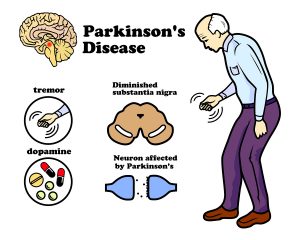introduction to Parkinson’s Disease
Parkinson’s Disease (PD) is a neurodegenerative disorder that affects the basic motor functions of the body. In a paper published by A. J. Lees, J. Hardy, and T. Revesz, it was found that there are estimated ten million patients of Parkinson’s Disease with majority of the patients over 60 years of age . Furthermore, the exact cause for PD is not yet determined. Thus, it can be concluded that further studies must be performed in order to treat and cure PD.The severity of PD can be calculated by measuring the tremors experienced by a patient; however, there are no devices available in the market with means to log the tremor acceleration for more than a few hours. Moreover, the products available to measure tremors in the industry require extensive medical attention to operate. There is an urgent need for a device capable of storing the tremor acceleration values for more than few hours. There is a lack of medical equipment that can provide a solution for detection, storage, and communication. Furthermore, there are no instruments available that can send the data to any desired email address.
Objective
The overall object of this project is to develop a prototype that can measure tremors in PD patients. There is a clear need for a product with the capacity to store tremor acceleration for at least 24 hours. The prototype has to operate without interrupting the natural movement of the body. Moreover, the device should send the average tremor acceleration values using email to any clinic and should have a display for the user.
Symptoms of PD
J. Jankovic describes four major motor symptoms of Parkinson’s Disease such as Bradykinesia, rigidity, postural deformity, and tremors , which are discussed in detail in Chapter 2. Out of these four symptoms, the tremors are a quantifiable and storable symptom. L.J.
Findley and L. Cleeves observed tremors at a fixed frequency between 4-6 Hz .
Implementation
The concept of tremor detection is implemented by attaching the accelerometer to a finger where the tremors can be clearly observed. The accelerometer accepts values of all three x, y, and z axes. The shaking palsy (tremors) is measured in terms of acceleration and frequency. In addition to the measurement of frequency and acceleration, the average acceleration per hour value is stored in an array. Moreover, this data is processed to determine whether or not the tremors measured were, in fact, tremors related to PD.
The acceleration of all three axes is processed and per hour values of the acceleration are stored in the microcontroller (Arduino board). Eventually, the per hour value of the acceleration is stored in computer as a text file. Furthermore, the per hour acceleration values are extracted from the text file to plot a graph of per hour average acceleration versus hours, and the text file is sent to any desired email address as an attachment. The LCD screen acts as a display for the end user that provides per second acceleration of the hand.



